All you need to know to integrate Salesforce and Asana

Ryan Chen
Content Marketing Associate
Learn about integrating Salesforce and Asana, common use cases (such as streamlining the sales to post-sales handoff), and how to maximize productivity and efficiency.
Introduction
Between prospecting, follow-up, and administrative work, sales teams have their hands full. Most reps are juggling multiple accounts at the same time, dealing with lead qualification, pre-deal support efforts, customer kick-off calls, demo preparations, contract-to-cash processes, post-deal onboarding activities, and more. It’s no surprise, then, that today's sales professionals spend just 36% of their time selling.
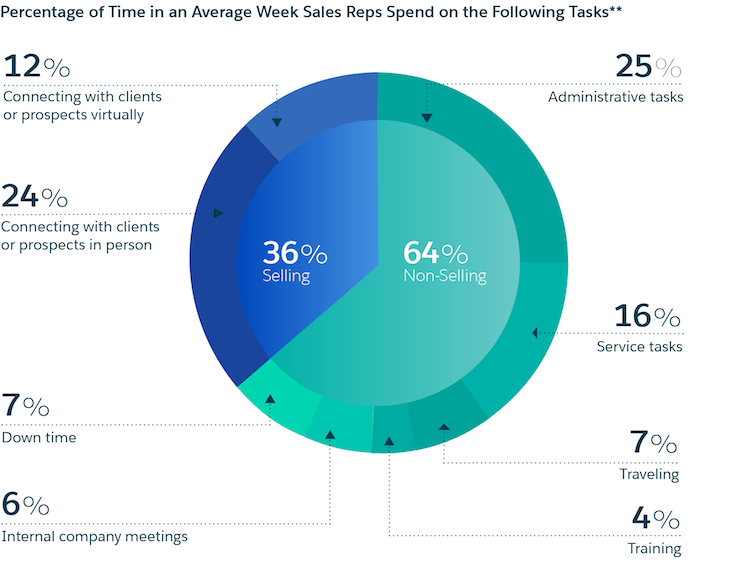
Average time spent on tasks by sales reps. Image courtesy Salesforce.
Tools such as Salesforce and Asana empower you to better manage your sales-related tasks and projects, including approvals for RFPs, deal desk, and the all-important sales-to-support handoff process. But many organizations struggle to experience real increases in productivity when implementing these tools, simply because they don’t play well together. After all, you probably do most of your work inside siloed sales tools (such as Salesforce), and project management tools can quickly become just another place to waste time updating basic information.
But what if you could effortlessly sync Salesforce and Asana in real time, so that users across your organization could work in both tools to manage projects more efficiently, without the manual work? Integrating Salesforce and Asana together gives you the power to seamlessly flow data between applications so you can onboard new customers faster, improve sales productivity, streamline project execution, and win more deals.
In this guide, we’ll break down how you can set up a quick Salesforce-Asana integration of your own, as well as share a few common Salesforce-Asana use cases. Salesforce already offers a native integration with Asana, but you might also be looking for a more-flexible, robust solution that meets your team’s exact needs. If you are, then jump ahead to our section on using general automation to build custom automated processes that level-up your sales project management. Otherwise, let’s get started.
How to integrate Salesforce and Asana
If you’re integrating Salesforce and Asana for the first time, here are a few important details to keep in mind.
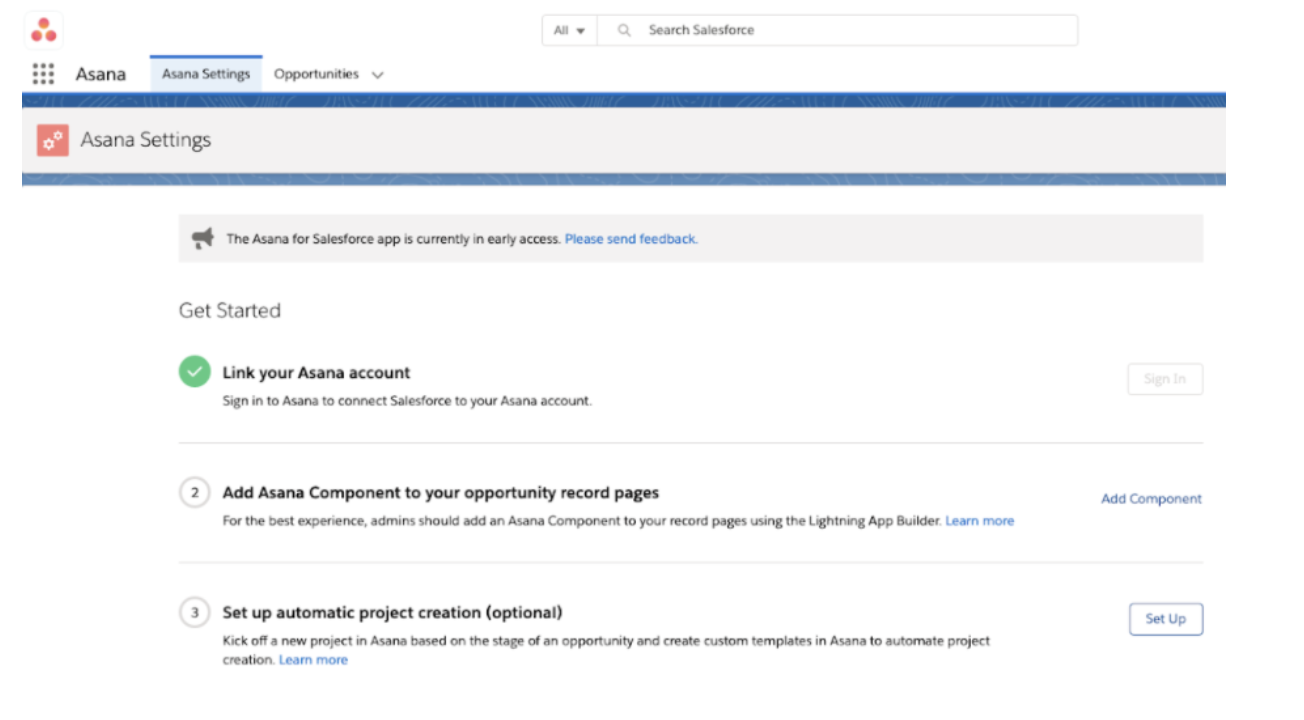
Integrating Salesforce and Asana.
You must be a business or enterprise customer with Asana.
You must be an enterprise or unlimited customer with Salesforce.
Salesforce optimized its Asana integration for Salesforce Lightning, but it is also compatible with Salesforce Classic. There are few differences between Salesforce Classic and Lightning from a functionality standpoint, however. Notably, there are nuances in the user interface to keep in mind as you set up the integration. For example, the look and feel of the VisualForce page differ between the two versions, and will require additional steps unique to your respective Salesforce instance.

Salesforce VisualForce Classic (left) vs. Salesforce VisualForce Lightning (right)
With the Salesforce-Asana integration, you can set up automation rules to automatically create new projects within Asana. For example, you might want to create a new project for new customer onboarding after closing a deal. Using custom templates, which duplicate common workflows and processes in ready-to-go project setups, you can dynamically generate new projects in Asana, based on this specific trigger from Salesforce. Asana projects you create with the automation rule are automatically named and bucketed into the Asana widget project section.
Note: You can find the Salesforce-Asana integration in the Salesforce AppExchange. If you’d like a step-by-step guide on how to set up this integration, you can refer to the Asana for Salesforce integration user manual.
What can you do with the Salesforce-Asana integration?
Salesforce’s native integration for Asana integration unlocks interoperability between the applications, enabling you to access one tool’s component without leaving the other. Here are a few examples of the Salesforce-Asana integration in action:
Perform Asana actions without leaving Salesforce
With the Salesforce-Asana integration, you can execute Asana actions directly within Salesforce:
Connect tasks and projects to specific Salesforce records and assign them to cross-functional team members. Once you associate a Salesforce record with an Asana task or project, you can directly request work, assign tasks, or monitor progress inside Salesforce. For example, you can streamline contract approval during the pre-sales process by easily requesting your leadership and legal team for review. Note: You can only add up to 35 Asana tasks per Salesforce record.
Track Asana work connected to a specific record. You can track incomplete tasks, due dates, assignees, follow-ups, comments, notes, accounts, opportunities, and deals directly within your Salesforce instance.
Complete Asana actions directly within Salesforce, such as marking a task as complete, leaving a comment, viewing task details, assigning a task, adding an attached file, downloading a file, or adding a subtask.
Perform Salesforce actions without leaving Asana
You can also execute Salesforce actions directly within Asana:
Freely flow Salesforce data such as customer details, leads, opportunities, and deals across the Asana domain to drive full-funnel visibility. For example, any time you create an opportunity in Salesforce, you can automatically generate tasks in Asana complete with full lead context. Tasks that feature Salesforce object data are called rich previews.
Rich previews are single data uploads that do not update. The details and order displayed in the rich preview are determined by the fields included in the Salesforce record.
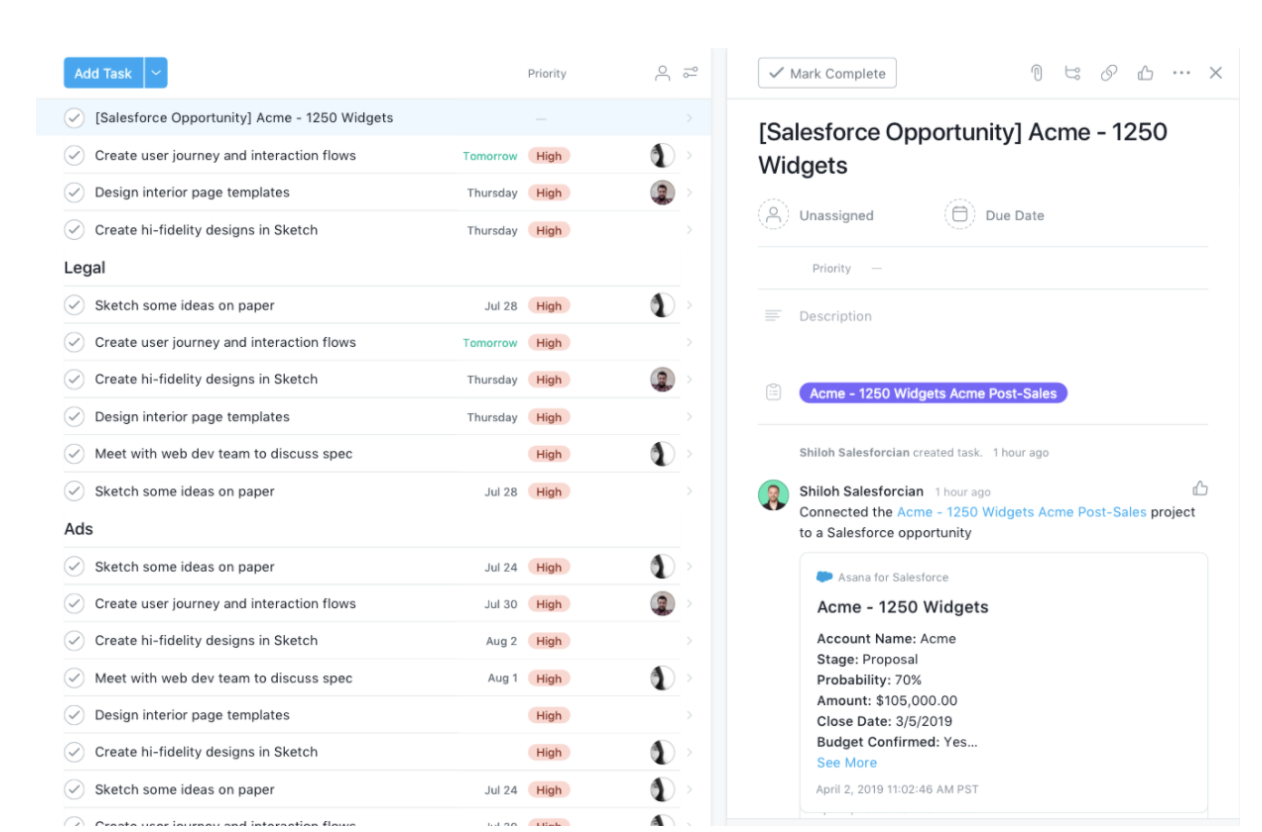
Viewing Salesforce data in Asana through rich previews.
Streamlining the sales to post-sales handoff
The customer journey doesn't end after you win a deal and land a new customer. You also need to hand off key context and processes to your support team to ensure a seamless customer onboarding experience. A frictionless transition from your sales teams to your internal post-sales team will maximize the chance that your customers onboard successfully and become loyal, long-term accounts. Also, ensuring rapid product adoption can drive revenue—research suggests that increasing retention rates by just 5 percent can increase revenue by 25 percent to 95 percent.
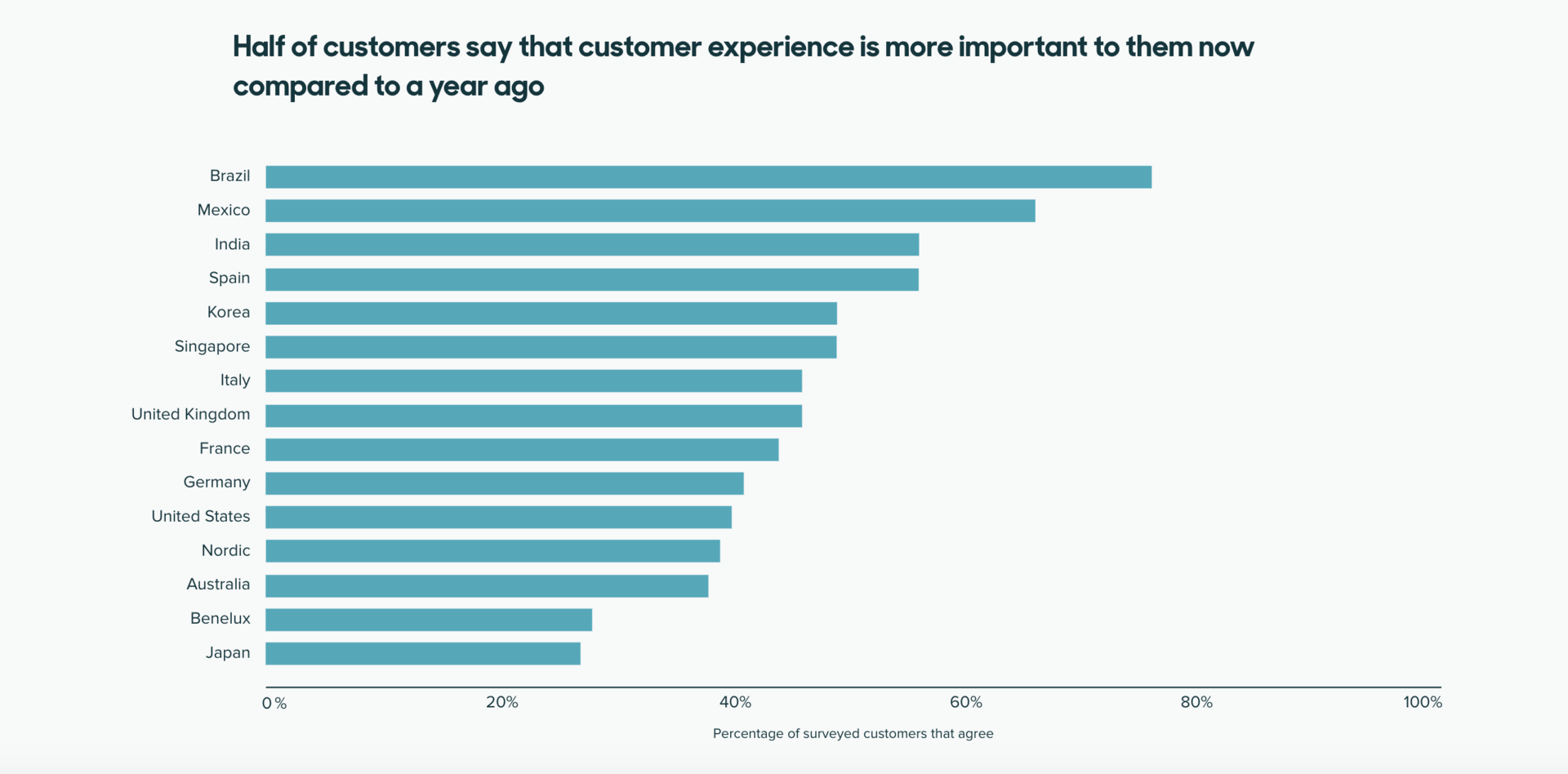
50% of customers say that customer experience is more important to them now compared to a year ago. Image courtesy of Zendesk.
By flowing data across Asana and Salesforce, you can streamline the sales to post-sales hand-off and onboard customers faster than ever before. Plus, you can set up processes that facilitate cross-functional approvals across customer support, account management, and implementation to maximize internal process efficiency.
You can automatically create new projects and tasks for post-deal hand-offs using the aforementioned Asana automation rule. The automation rule is triggered when an opportunity’s Salesforce deal stage changes (in this case, changing to the 'opportunity won' stage). Some tasks you can create include building an implementation plan, creating shared goals, kick-off calls, on-site demos, follow-up calls, and periodic check-ins.
How to integrate Salesforce and Asana with a General Automation Platform
The native Salesforce for Asana integration offers a convenient, reliable way to flow data between applications. But what if you need to handle more-sophisticated processes that go beyond simple data syncs? What if you need to perform complex operations, such as unifying data between multiple sources, scheduling time intervals, including data within custom fields, executing updates in bulk, and more? Unfortunately, the native integrations may be inadequate to meet these needs because of its limited functionality.
Let’s say that you need to automatically sync only specific fields any time you update an associated Salesforce record. Or, you need to add or remove Salesforce records in bulk whenever you update tasks in Asana. Or maybe you need to bi-directionally sync data across not only Asana and Salesforce, but also any number of other applications. In any of these examples, the native Salesforce for Asana integration won’t suffice.
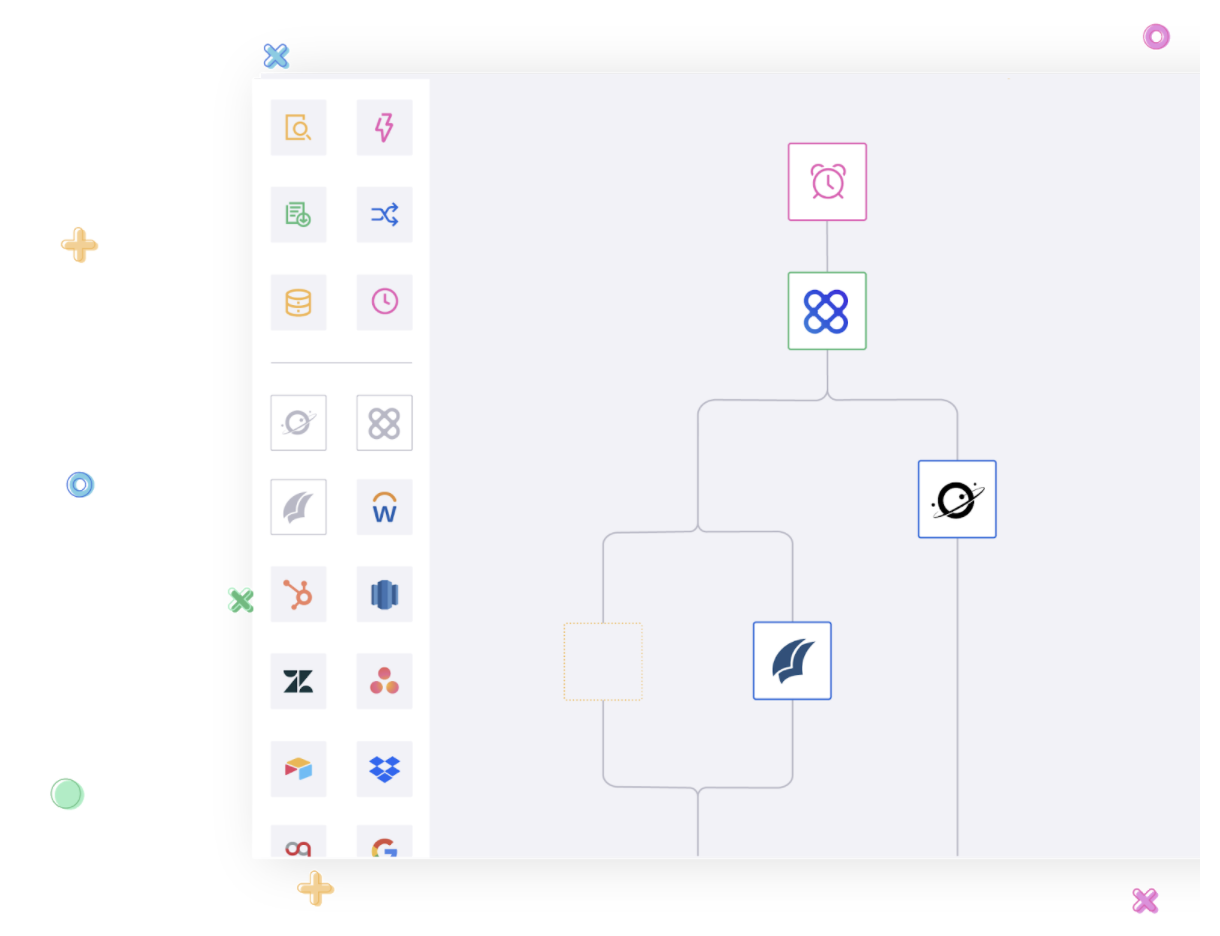
A General Automation Platform.
To handle more-advanced integration use cases, teams at leading firms are looking to General Automation Platforms (GAP). A GAP is a low-code platform that empowers business users of any technical level to stand up powerful integrations rapidly. Anyone can use a GAP’s visual, drag-and-drop interface to rapidly build API-level integrations between any number of applications in minutes. Additionally, you can use a GAP to easily orchestrate powerful, multi-step automation that kicks off a variety of operations, responding to any custom trigger. With a GAP, you can save hours of manual work, drive productivity, and scale mission-critical processes.
Here’s an example of a GAP in action, not only standing up custom integrations with ease, but also orchestrating Asana-Salesforce automation involving multiple tools and multiple operations. This workflow demonstrates how you can take control of your Asana and Salesforce data by using a mix of pre-built connectors, logic-based operators, and data helpers to align your sales and post-sales teams.
More Asana-Salesforce integration resources
With the power of general automation, you can deeply connect Asana, Salesforce, and any of the most essential applications in your tech stack. And a GAP’s unparalleled flexibility means you can automate any other manual process, such as lead routing, lead enrichment, lead-to-account matching, and more.
If you’re interested in seeing a General Automation Platform in action, join our next weekly group demo. You can also check out these resources to learn more about building dynamic integrations and automation: